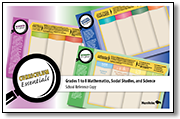

- School Reference Copy
- This collection is a printable version of this website.
Curriculum Essentials
Curriculum Essentials are resources designed to provide a “quick start” to the Manitoba curriculum for Mathematics, Science and Social Studies in Grades 1 to 8. Teachers need to plan and assess student learning using a large number of diverse curricular concepts that are organized in somewhat different ways. These resources present the essentials–the big ideas, the foundational processes, practices and skills–in a consistent visual format that still respects the unique nature of each discipline.
These resources help educators:
- manage and organize outcomes
- see links among the curriculum areas
- maintain a strong focus on foundational learning
Curriculum Essentials provide a pathway into the provincial curricula for different subject areas and are versatile resources that:
- provide a quick overview of grade-level learning for teachers new to a grade or subject area
- identify concepts, skills, processes, practices and competencies that are foundational to subsequent learning
- help planning for student learning and assessment of and for learning
- facilitate cross-curricular and cross-grade connections
- assist planning in multi-level classrooms
- present opportunities for literacy and numeracy learning
- highlight links with the Provincial Report Card categories
- identify the ways of thinking and doing that are characteristic of a discipline and that will be developed across the grades
- support other aspects of curricular thinking, such as identifying “essential questions” and “enduring understandings”
- help learning support and EAL teachers identify relevant topics for vocabulary development and other literacy supports.
Curriculum Essentials do not replace curriculum and do not eliminate or sequence outcomes. They provide a view from above the terrain, helping educators see pathways and signposts through the curriculum, while encouraging pedagogical choices informed by knowledge of specific learners, context, and resources. Curriculum Essentials clusters outcomes into essential concepts or “big ideas” and highlights the foundational skills and ways of thinking that students need to develop along the way. Once educators have the overview of the curriculum, the provincial curriculum documents provide specific details and support for implementation.
The organization of various essentials may not be the only way that curricular outcomes can be organized, but they are presented as a catalyst for deeper conversation about curriculum.
The Curriculum Essentials documents can be used as a collaboration tool for school teams to:
- discuss planning for teaching and learning
- reflect on instructional and assessment practices
- examine the continuum of learning in each discipline and plan for individual student needs.


